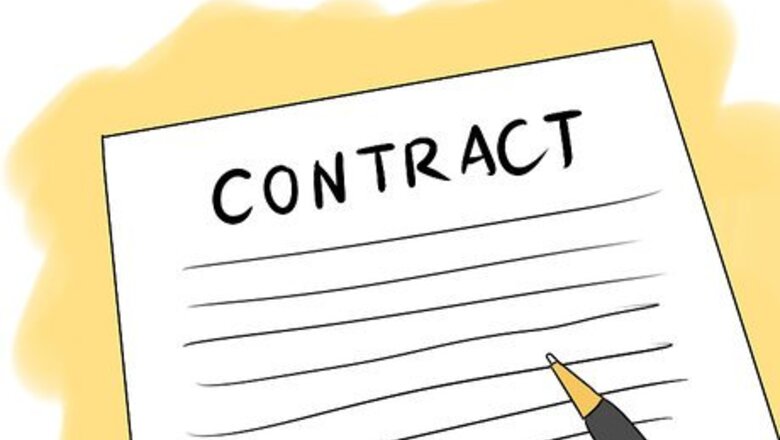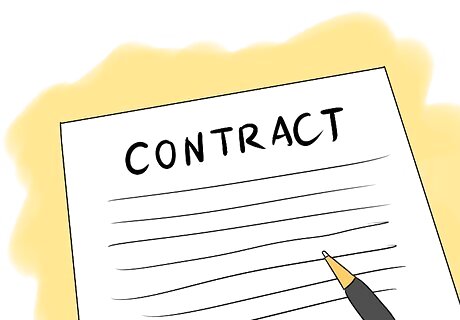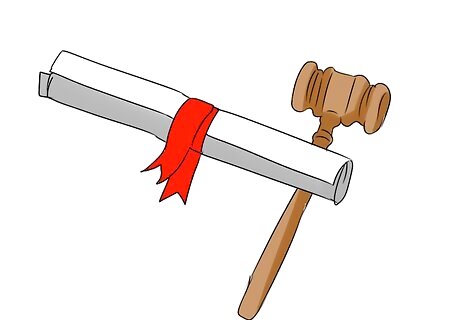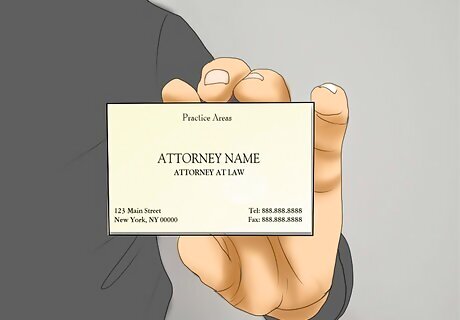
views
X
Research source
Negotiating with the Other Party

Evaluate the situation. Read through the contract you signed along with any other documents you have regarding the dispute. Try to look at this information from an objective, dispassionate perspective to get to the bottom of what has gone wrong and what can be done to fix it. Pay close attention to the clauses describing what constitutes breach of contract, particularly any "force majeure" clause – which details instances when performance is excused because the party is unable to perform due to circumstances out of the party's control, such as natural disasters. Weather is an issue in any construction project, so typically a climactic event must be major for the force majeure clause to apply. Extensive rains may occasion delays, but there typically is another provision accounting for this that requires particular notice. There also may be provisions that detail what should happen if materials aren't available by the established deadline, or if payments aren't made.

Send a letter to the other party. Once you have a handle on the nature of the dispute and the source of the conflict, contact the other party in writing. Mailing a letter provides a record of your efforts and also allows you to confirm receipt. Use standard business format and stick to the facts. Reference the contract where necessary and describe the circumstances or events that were out of line with the original plan for the project. Keep your tone civil and indicate you want to work to resolve the dispute. Provide a deadline for the other party to respond after receipt of your letter. When you've finished your letter, sign it and make a copy of the signed letter for your records. Mail the letter using certified mail with returned receipt requested. When you get the notice that your letter was received, keep it with your copy and mark the date of the deadline on your calendar.

Wait for a response. When you hear back from the other party, evaluate their position and try to find some common ground that you can use as a jumping-off point to reach a compromise. If the other party fails to respond by the deadline you provided, you may have to take other action. The other party may elect to call you, or may send you a written response. If the other party calls you, set a meeting to discuss the issue. Avoid getting into negotiations over the phone. As soon as you get off the phone, type a brief letter confirming the phone call and the date of the meeting, and send it to the other party. Sign your letter and make a signed copy for your records.

Discuss options to resolve the dispute. Depending on the response you received from the other party, it may be a good idea for the two of you to get together in person and look at ways to overcome the challenges you face. Try to arrange your meeting in a neutral location. You also may want to have the meeting at the job site if there are particular aspects of the work that you want to show the other party. Keep discussions civil, and stick to the facts. Even if the relationship is particularly tense, you want to avoid turning it personal or resorting to name-calling. The other party may try to make it personal, but don't respond in kind. Be open-minded, and at least consider any option that's put on the table. Something that seems ridiculous at first blush may turn out to be the best way to resolve the dispute once you give it a little thought. Keep your focus on finding a resolution to the dispute so the project can continue.

Get any agreement in writing. If you and the other party are able to come to a compromise that effectively resolves the dispute, create a written agreement or addendum to the original contract that describes the new terms. If you're writing the agreement, give the other party a chance to read through it carefully. If the other party writes the agreement, review it to make sure it reflects exactly the terms to which you agreed at the meeting. You may want to have a copy of the original contract with you. If the compromise you reached negates or alters any of the terms in the original contract, this should be addressed in the written agreement. If you have any questions about how the compromise affects the original contract, you may want to consult with an attorney. The written agreement should be signed by both parties. Once it's signed, make a copy for each of you.
Using Alternate Dispute Resolution

Determine if the contract requires alternate dispute resolution (ADR). Many construction contracts include a clause that requires any contractual disputes to be submitted either to mediation or binding arbitration for resolution. This clause typically can be found toward the end of the contract, within the document's miscellaneous provisions. If your contract has an ADR clause, it typically will lay out the exact procedure to be followed. Use the contract procedures to avoid being accused of being in breach yourself. Your contract may specify mediation or arbitration. Mediation is a voluntary process in which the two parties sit down and negotiate a resolution to the dispute with the help of a neutral, third-party mediator. The mediator is trained in dispute resolution and can facilitate your discussions. In contrast, arbitration is more like a trial. You and the other party present your cases to an arbitrator or panel of arbitrators who then decide who's right and who's wrong. Arbitration may be binding or non-binding. However, if you and the other party create a written agreement embodying the terms of the dispute resolution, that agreement becomes a legally binding contract.

Find a local mediator or arbitrator. If the contract does not specify a particular organization or group to use, you'll have to find an accredited mediation or arbitration service nearby that is willing to handle your dispute. There are a number of national mediation and arbitration groups that specialize in construction contract disputes. The professionals who work for these groups have expertise in construction law and understand the challenges and nuances of construction projects. You also can find ADR organizations by contacting the local court or bar association. Typically they will have lists of accredited and approved ADR organizations. You want to choose a mediator or arbitrator approved by the court system in the event you later have to file a lawsuit.

Notify the other party. If you plan to engage the ADR clause in the contract, you typically must provide written notice to the other party within a specified period of time before the date of the ADR appointment. Look to your contract for details about what must be included in the notice. If your contract doesn't specify, you should include the name, date, and location of the proceeding, as well as a summary of the issues to be considered or discussed. Attach to your notice any application or form you filled out requesting mediation or arbitration. You also should include any information from the ADR provider. Some ADR providers may require the parties to submit written arguments or evidence prior to the appointment.

Appear on the date scheduled. Your ADR provider typically will give you and the other party information on how to prepare for the appointment and whether you can bring evidence or witnesses along with you. Rules regarding the admission of evidence in an arbitration proceeding are somewhat relaxed, but still follow the basic rules of evidence in the court system. Witnesses take the stand and are asked questions under oath. Although not required, you typically are allowed to have an attorney represent you in an arbitration proceeding. In mediation, the rules are more informal. You typically can bring along whatever you want that supports your side of the dispute. Witnesses can speak to the mediator and present their testimony directly.

Participate in the proceedings. Your role in the ADR proceedings typically will vary depending on whether you're using mediation or arbitration. Mediation proceedings tend to be more informal, while arbitration hearings work a lot like a court trial. At a mediation proceeding, the mediator typically will meet with everyone and go over the rules, then the parties will move to separate rooms. The mediator goes back and forth between you attempting to resolve the dispute by helping you better understand the other side, but he or she does not make a decision regarding who's right and who's wrong. With mediation you have more control over the outcome because any compromise reached will be a resolution created by you and the other party. In contrast, arbitrators are more like judges. They hear both sides of the dispute and then render a verdict. If you are in binding arbitration, the arbitrators' decision controls the outcome of the dispute – even if both you and the other party hate it.

Sign a written agreement. Whatever resolution of the contracting dispute comes out of ADR should be in writing and signed by both parties so its terms will be legally enforceable to the same degree as your original contract. If you reached a compromise through mediation, the mediator may write up the terms of the compromise for you. Both you and the other party still should review this written agreement before you sign it and make sure it reflects your understanding. In the case of an arbitration hearing, the arbitrators will release to you a final resolution which is similar to a court order. Unlike mediation, you have no control over the arbitrator's final decision because you already agreed to be bound to it when you signed on to binding arbitration.
Filing a Lawsuit

Gather information about the dispute. In preparation for filing a lawsuit, you will need your contract as well as all documents and other evidence of any breach of contract on the part of the other party. Keep in mind that in a breach of contract case, you typically must attach a copy of the original contract to the complaint. In addition to the contract, gather other information about the particular incident that gave rise to the dispute, as well as proof of other efforts you've made to resolve the dispute before filing a lawsuit. Some courts require proof that the parties attempted to resolve a dispute privately before submitting their dispute to the courts.

Choose the correct court. The amount of money at stake and the identity of the parties may determine which courts are available to you if you want to file a lawsuit to resolve your construction contract dispute. If a relatively small amount of money is at stake – say, a few thousand dollars – you may be able to file your lawsuit in small claims court. Small claims may be preferred because the simplified process is designed so laypeople can represent themselves, and resolution is reached cheaper and more quickly than in state civil court. #*However, in some construction cases you want to seek an injunction, which is a court order for the other party to do something or stop doing something related to the dispute. Small claims courts typically handle cases involving money damages only, and cannot issue injunctions. Additionally, if you signed the contract and are suing on behalf of an LLC or corporation, you may not be able to file a lawsuit in small claims. Some states restrict small claims courts to individuals, and while a business can be a defendant in a small claims case, it cannot file suit itself.

Consider consulting an attorney. Depending on the court in which you plan to file your lawsuit and the damages at stake, you may need the assistance of an attorney to efficiently navigate the legal system and resolve the dispute. Generally, you want to look for an attorney with experience handling construction disputes. The attorney you use should have a background in breach of contract litigation and construction law If you had an attorney when you entered the contract, you might consider talking to them. Although that attorney may not personally handle litigation, they may be able to recommend someone who can effectively handle your case. If you know the other party already has an attorney they plan to use, you definitely want to have legal counsel on your side as well.

Draft your complaint. You initiate your lawsuit with a complaint, which you'll file in the court you want to hear the case and resolve the dispute. The complaint includes the factual allegations that you assert constitute a breach of the contract. Depending on the court you use, you may be able to find a form to fill out. Small claims courts in particular have forms available to file an initial complaint. To find a form, contact the clerk's office of the court where you want to file your lawsuit. You also can find out about filing fees, procedures, and any other documents you may need to complete along with the complaint itself. If no forms are available and you are representing yourself, ask the clerk for a copy of a complaint filed in another breach of contract case with the same court that you can use as a sample to guide you. Generally, your complaint will set forth specific allegations that add up to a breach of contract, as well as the exact amount of monetary damages you're seeking or order you want the court to enter.

File your complaint. Your completed complaint must be filed with the clerk of the court where you want your lawsuit heard. Take your original signed complaint along with at least two copies. The clerk will keep the originals for the court's files and return the copies to you. When you file your complaint, you must pay filing fees. These fees vary from around $100 or less for a small claims case to several hundred dollars for a state civil court case. If you cannot afford the filing fees, you can ask the clerk for a fee waiver application. You must provide information about your income and assets on the application, and if they fall below the court's threshold you won't have to pay filing fees. After your complaint is filed you must have the other party served. Typically you get a sheriff's deputy or private process server to hand-deliver the documents. The server will complete a proof of service form which must be filed with the court. Some courts also allow you to use certified mail with returned receipt requested. If you use this method, you'll have to fill out and file the proof of service form yourself when you get the receipt in the mail.

Wait for a response. When the other party receives the summons and complaint, they have a specific amount of time – typically only a few weeks – to file an answer or other response to your complaint, or you may be eligible to win by default. The amount of time the other party has to respond is much shorter in small claims than in lawsuits filed in state court. Some small claims courts don't even require a written response – you simply show up at the scheduled hearing. When the other party files a written response, it will be served to you just as you served the complaint on them. Don't be surprised if the other party denies most of your allegations. The other party also may include counter-claims against you. If there is a counter-claim, you must respond to it in the same way the other party responded to your complaint. At the same time, the other party may reach out to you in an attempt to resolve the dispute outside of court. Consider settlement offers with the understanding that it may be months before the matter is concluded in court.


















Comments
0 comment